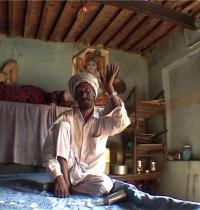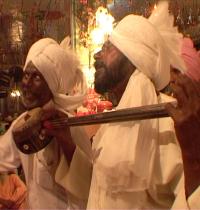Gurvinder Singh
Grant Period: Two years
Filmmaker Gurvinder Singh argues that documenting the bhakti and Sufi music of the Punjab through the language of film is a veritable challenge. His interest in the pan-Indian bhakti tradition was triggered by his research on the Warkari, the ‘cult’ of worshipping the poet-saints of Maharashtra, which formed his diploma film project at the FTII.
By replacing the sacrificial rites and monistic meditation propounded by Brahmanical Hinduism with a ‘new attitude to god’, the bhakti movement not only changed religious expression, but catalysed the birth of new forms. The history of the bhakti movement, especially bhakti music in the Punjab, is at best a fractured history, given the lack of serious research or documentation on the subject. In the Punjab, it is known to have percolated down from Kabir, whose writing had a direct influence on Nanak, thereby inspiring the basic tenets of Sikhism. Parallel to the development of Sikhism and the poetry of the gurus in the Punjab, there was a strong Sufi kavya-dhara enriched by the Sufi poets and mystics like Shah Hussain, Sultan Bahu and Bulleh Shah, among others. There were close thematic correspondences between bhakti and Sufi as well.
The Sufi poets used the symbol of the relationship between lovers to signify the longings for union with the Divine. The popular stories around the theme of love in the Punjab, like Heer-Ranjha, Sohni-Mahiwal and Mirza-Shahiban, were rewritten and given new interpretations. The demarcations between Hindu and Islamic folklore, poetry, literature and music became blurred in the work of the Sufi and bhakti poets. Citing Alka Pande’s book on the folk music traditions in the Punjab, Mr. Singh outlines the causes that threaten the ‘folk’. The vanishing of feudal patronage, the freedom to pursue non-traditional vocations, the advent of technology and the diffusion of Punjabis across the globe, leading to a demand for an international music, have together contributed to the undermining of the folk. Encountering both the loss of context for performance and audience, these ‘folk’ musicians are a gradually ‘vanishing’ community. Besides, since the transmission of these forms happens within a guru-shishya parampara and is primarily oral, and there are no formal institutional processes to either document, preserve or impart skills, these musical forms would soon fade into oblivion.
Mr Singh will adopt a two-pronged method in documenting the bhakti and Sufi musical traditions in the Punjab: he will undertake video documentation of the performing traditions, performing artists and locations where such traditions are practiced, and make a documentary film. Before embarking on documentation, however, Mr Singh will undertake preparatory field research for six months. He will travel extensively in the Punjab meeting artists/musicians, scholars and instrument makers, and visiting museums, fairs, religious places and other locations associated with bhakti and Sufi music.
The field research will enable Mr Singh to determine the scope and nature of the film, and develop the treatment, narrative and a draft script. Shooting schedules would be fixed in accordance with seasons, festivals and fairs. Mr Singh feels that a yearlong shooting schedule would allow him to intersperse shooting with additional research that might be required for actual filming. Theatre director, Neelam Mansingh Chowdhary, music scholar, Alka Pande, and musician/film scholar, Madan Gopal Singh, are some of the eminent people whom he hopes to approach for guidance.
The audio-visual documentation and filming will be done on a digital video camera. Funding for the costs of editing/post-production would be raised from other sources. Mr Singh would make the documentation available to private/government organisations and interested individuals. He suggested the Sangeet Natak Akademi and the Punjab Academy as possible venues for housing the textual and audio-visual documentation. He plans to screen the film widely or market it later to television channels. Mr Singh would also attempt to create a platform for the traditional artists with the help of organisations like Spic-Macay.




